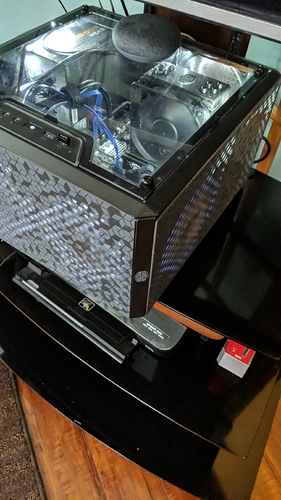Sorry if I didn’t mention it but I’m speaking moving to X86 architecture running Linux (I use only real OS such as Linux, not the b*llshit of some framed companies ![]()
I upgraded about 3 months ago to a custom PC i5 8400 8gb ram best decision ever had to figure out what to fill up the extra space with (a good problem to have)
![]()
Running HA in a VirtualBox VM, and it’s a joy. Host system is a i7 laptop.
Upgraded for similar reasons. Despite my attempts at using external/network storage on my Pi 3 along with a separate MariaDB VM, performance just wasn’t cutting it for me. I went with an Ubuntu VM + Docker on my ESXi host (free license). I was able to forward my Z-Wave stick, which was my biggest concern.
Had similarly great experience with my migration. I wrote what I did here My migration to improve Hassio performance and increase security
Is there any guide on running HA on a VM? Do you pay for the VM?
What issues have you got with shell command? I am facing the same 
??
A VM is just another computer on the network. You don’t pay if you run the VM yourself.
Setup VM (Ubuntu/Debian/whatever), then follow literally any of the preferred ways to install HA on a Linux distro. Python, docker, hassio on docker…
My guy always to the rescue thanks for your help and knowledge man God bless 
Virtualbox is free. There are hassio images for virtual appliances. https://www.home-assistant.io/hassio/installation/
I run hassio in virtualbox on my windows laptop, just experimentally. Works fine. Note: some virtual systems may have problems passing usb devices to hassio, which means z-wave/zigbee sticks won’t work.
What machine were you using to host the MariaDB database? I find the speed of that machine has just as much effect as the machine actually running HA.
I used the pi Hassio addon. Memory use doubled but I still had 50% free and the performance vastly improved over the SQLite default db.
I run hassio inside proxmox VE (which is a hypervisor) on my Dell optiplex 9020 micro (i5 8gb ram, 250gb ssd). Passing USB devices are like putting them in and click the pass to host button. Z-wave works like a charm. Performance is beast and power usage is low. If you’d want to get into it I could help you out. I was thinking creating a tutorial series.
Yeah but you can’t do that with Hyper-V
Then use proxmox, ditch hyper-V. The plus side to proxmox is debian under the hood.
I have a proxmox VM host. I’ve been using Proxmox since 2009. I don’t use Hyper-V, I was elaborating on the comment he made.
My HA runs in docker on a dedicated NUC.
Haha lol. Proxmox is dope. I don’t have a nuc  couldn’t get the nuc image to work on my optiplex micro pc.
couldn’t get the nuc image to work on my optiplex micro pc.
Using a raspberry pi and after spending an eternity getting my lovelace just right my SD card died! What was worse was it was in the middle of taking a hassio snapshot! So I looked into installing on my existing windows server (HP N54L with a SSD and 8gb ram) and after some advice on here went with using a virtual machine using The Hook Up guide here https://www.youtube.com/watch?v=vnie-PJ87Eg
Reboots are much faster, only get warnings about custom components in the log and it has more grunt to be able to use camera streams (I have a load of cheap Yi cameras which are being given a new lease of life with Yi Hack V4 allowing RTSP and MQTT).
Have moved away from using duckdns since I’m already paying for the cloud service and means that I don’t have to open any ports. Tried node red but couldn’t get the hang of it so sticking with YAML for now.
Only thing I haven’t been able to get working at the moment is zigbee2mqtt so I’ve left that running on my Pi (if anyone has any hints it would be appreciated)!
I don’t use hassio. I find no value in it for MY setup. I just use normal home assistant docker.
